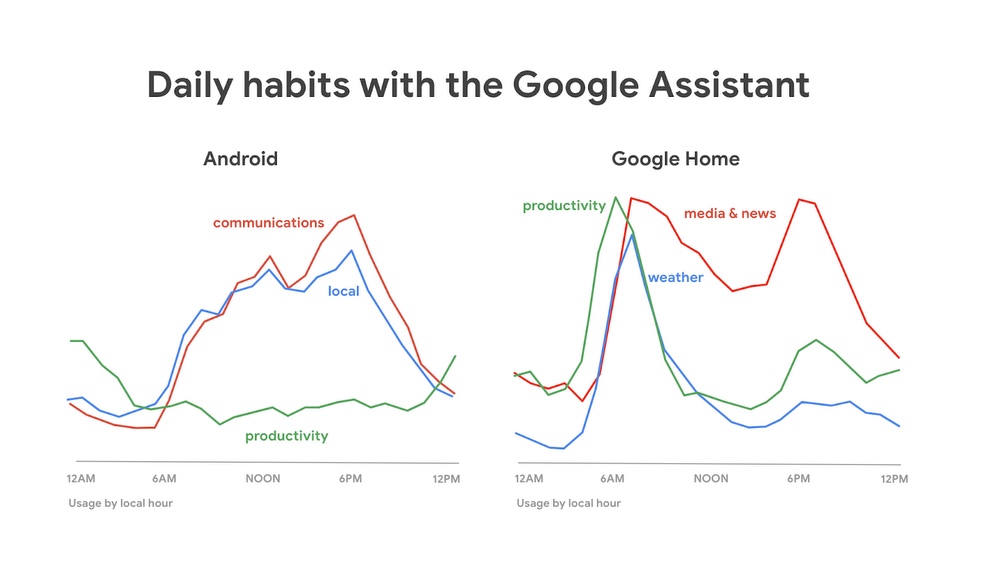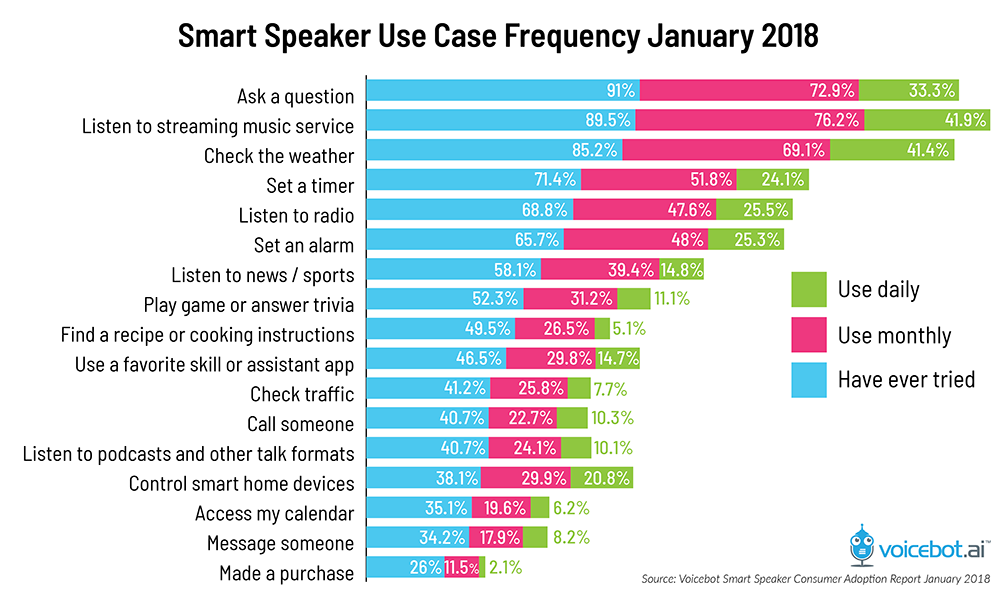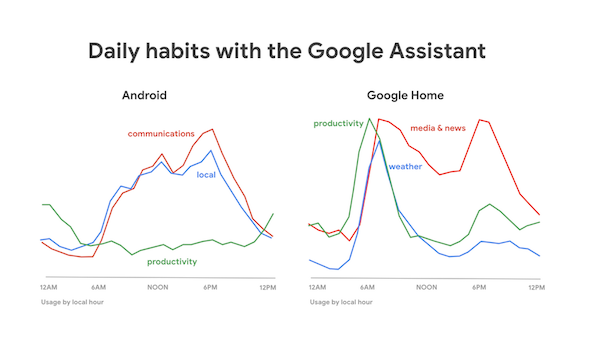Google Assistant Data Show Different Usage Patterns By Device and Time of Day
Scott Huffman, Google Assistant vice president of engineering shared some revealing data about Google Assistant use in a blog post this week. The data show different Google Assistant usage patterns for Android OS devices and Google Home. You can think of this as primarily smartphone and smart speakers respectively. Data also reveal varying usage patterns based on time of day as consumers fit Google Assistant use into both existing routines and new ones. Huffman writes:
“In the morning, we’ll use our smart speakers to ask for the weather or listen to the news. During lunch and on the commute home, we’ll text and call our friends, or look for local restaurants. When we get home, we want to listen to music. And at the end of the day, we get ready for tomorrow with tasks like ‘set an alarm,’ ‘set a reminder,’ or ‘ask the Assistant to tell me about tomorrow’s meetings.’”

Voice Use Cases Driven by Context
Jan König, co-founder of Jovo commented in a recent Voicebot Podcast interview that voice app developers should think context-first when designing an app. There are many aspects of context, but König suggests that the device may be the most important. This position is logical because devices not only indicate capabilities, but also are closely related to other aspects of context such as environment, common use cases and user state of mind.
It is not surprising that Google Assistant on the smartphone is predominantly used for communications and local information such as navigation. Those are core features of smartphones. The more surprising finding is the very low usage of productivity tools on the smartphone. It may be that during the day users are accessing productivity tools on a laptop or similar device, but smartphones have a plethora of productivity tools. It would be wrong to conclude that consumers are not using productivity apps on smartphones. They simply are not accessing them through Google Assistant. That could be a function of habits or it could be that few productivity tools have figured out how to effectively take advantage of voice integration.
One thing Google Assistant users on smartphones appear not to be doing often is accessing content using the voice assistant. This again may be because consumers are accustomed to accessing content sources on smartphones through other means such as within a mobile app. It may also be an awareness issue or the fact that many of the traditional content sources have not yet transitioned to voice accessible user experiences.
Smart Speaker Use Biases Toward Content Consumption
By contrast, media and news content consumption is the dominant use case for consumers using smart speakers. There is a window in the morning where productivity and weather voice apps have strong usage and a small bump for productivity in the evening (I wonder if the productivity app rise around 7:00 pm includes cooking apps), but media and news are consistently high throughout the day. This aligns with consumer survey data showing music consumption as the top smart speaker use case.

Smart speakers are optimized for audio consumption. Smartphones are not. That is a big reason why headphones and ear buds are such a big business. Out-of-the-box smart speakers naturally fill the room with sound. The audio fidelity of the entry-level devices such as Google Home Mini is not particularly good, but it is suitable for many situations. If consumers begin investing in devices with higher quality speakers, this consumption should only increase.
It’s also worthwhile to note that smart home control is not one of the top three use cases for Google Home users today. Many smart speaker early adopters were drawn to the product category because of smart home support, but as the devices have gone mainstream, it has become a less important use case. Only about 2 in 5 consumers have ever used their smart speaker for smart home control and only about 1 in 5 do so daily.
Optimize for the Favored Use Cases
This data should be useful for voice app developers. If you have a communication tool, it is most likely to be used on smartphones today. If your voice app is for media, then the smart speaker is most important right now. This mix may change over time, but should be instructive in terms of the intersection of context, device and use case. It might also shed light on which segments are the most promising today for voice app growth.
A final note to consider is the focus of Siri. Apple’s voice assistant has been criticized for its narrow focus on a limited number of domains. However, the domains it did support were closely related to how consumers are using Google Assistant on smartphones and until recently the Apple didn’t have a smart speaker offering. When it launched HomePod the company focused on media, namely music, consumption use cases. It largely lacks access to media beyond recorded audio through Apple Music so the most important strategy to support HomePod may be to recruit other media providers to support the platform.
Follow @bretkinsella Follow @voicebotai
Google Assistant to Get Follow Up Mode and Compound Requests









